
effect of temperature on solar cell voltage
As a great potential renewable energy source, solar energy is becoming one of the most important energies in the future. The changes in internal parameters with comparison and temperature effect from 293 K to 323 K are considered to plot the performance curve. Physics behind this phenomenon is that, with increase in temperature open circuit voltage decreases and reverse saturation current increases. The solar cell is the basic building block of solar photovoltaics. The Nominal Operating Cell Temperature (NOCT) is the value of temperature reached by open-circuited solar cells in a module under certain conditions. This is why the power output of a solar panel decreases along with the rise of cell temperature. Additionally, the voltage drop on the PV cables increase as the temperatures go higher. For example, let us say that the heat of the surrounding environment causes the solar cells temperature to reach 60C. The energy production efficiency of solar panels drops when the panel reaches hot temperatures. When charged by the sun, this basic unit generates a dc photovoltage of 0.5 to 1.0V and, in short circuit, a photocurrent of some tens of mA/cm2. As solar panels are made from silicon, one factor is the effect of temperature on the silicon. I. sc, and . The current supplied by the solar panel will rise marginally but the voltage drops somewhat faster so the power (voltage times current) is lower. (2 I SC = I max, at V = 0 (16) 2.
A cell temperature of 64C in this environment will equal a loss of 14% in energy efficiency.
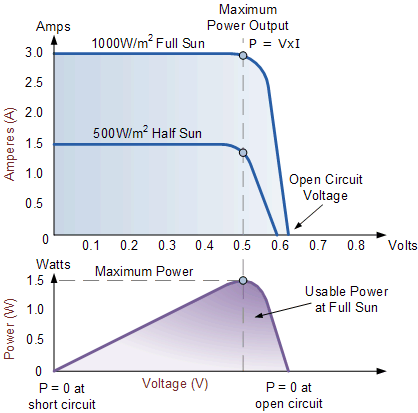 These pertain to the test environment conditions wherein the I cannot give you a rigorous explanation, but I think (but I'm not totally sure) that the increase of temperature causes the increase of the electrons' kinetic energy. When solar light intensity increases from 200 w/m 2 to 1000 w/m 2, the load or s/ccurrent (I L) increases as shown in Table 2 above. A new series of thiophene-based azomethines differing in the core structure was synthesized. Effect of solar cell temperature on its performance K. El-Adawi1 , S.-E.-S. Abd El-Ghany2, S.A.Shalaby1, M.A.AttallahM. The solar cells are made of semiconductor materials, such as commonly used crystalline silicon. Published 2011. The hot spot effect refers to the fact that under certain conditions, a solar cell module that is shaded in a series of branches will be used as a load to consume the energy generated by other solar cell modules that have light, and the shaded solar cell module will heat up at this time. Solar cell properties can be altered by changes in environmental conditions such as temperature. In this paper, the performance and overview use of solar cells is expressed. The overall effect of temperature on solar-cell parameters results in a positive temperature coefficient of the power conversion efficiency, which is 1.9 % at T = 320 K and 100 mW cm 2 (2.5 % at 0.7 mW cm 2 ). #3. m.s.j. Because it takes less energy to create The main effect of increasing temperature for silicon solar cells is a reduction in Voc, the fill factor and hence the cell output. Effect Of Temperature On A Solar P/N Junction. are considered. The obtained compounds exhibited the ability to form a stable amorphous phase with a high glass transition temperature above 100 °C. They were -0.2 to 0.4%/C. Solar cells vary under temperature changes. The change in temperature will affect the power output from the cells. The voltage is highly dependent on the temperature and an increase in temperature will decrease the voltage. Figure 2: Output I-V characteristics of the PV module with different temperatures The current voltage characteristics, I-V , are measured at different temperatures from 25C to 87C and at different illumination levels from 400 to 1000 W/m 2 >, because there are locations where the upper limit
These pertain to the test environment conditions wherein the I cannot give you a rigorous explanation, but I think (but I'm not totally sure) that the increase of temperature causes the increase of the electrons' kinetic energy. When solar light intensity increases from 200 w/m 2 to 1000 w/m 2, the load or s/ccurrent (I L) increases as shown in Table 2 above. A new series of thiophene-based azomethines differing in the core structure was synthesized. Effect of solar cell temperature on its performance K. El-Adawi1 , S.-E.-S. Abd El-Ghany2, S.A.Shalaby1, M.A.AttallahM. The solar cells are made of semiconductor materials, such as commonly used crystalline silicon. Published 2011. The hot spot effect refers to the fact that under certain conditions, a solar cell module that is shaded in a series of branches will be used as a load to consume the energy generated by other solar cell modules that have light, and the shaded solar cell module will heat up at this time. Solar cell properties can be altered by changes in environmental conditions such as temperature. In this paper, the performance and overview use of solar cells is expressed. The overall effect of temperature on solar-cell parameters results in a positive temperature coefficient of the power conversion efficiency, which is 1.9 % at T = 320 K and 100 mW cm 2 (2.5 % at 0.7 mW cm 2 ). #3. m.s.j. Because it takes less energy to create The main effect of increasing temperature for silicon solar cells is a reduction in Voc, the fill factor and hence the cell output. Effect Of Temperature On A Solar P/N Junction. are considered. The obtained compounds exhibited the ability to form a stable amorphous phase with a high glass transition temperature above 100 °C. They were -0.2 to 0.4%/C. Solar cells vary under temperature changes. The change in temperature will affect the power output from the cells. The voltage is highly dependent on the temperature and an increase in temperature will decrease the voltage. Figure 2: Output I-V characteristics of the PV module with different temperatures The current voltage characteristics, I-V , are measured at different temperatures from 25C to 87C and at different illumination levels from 400 to 1000 W/m 2 >, because there are locations where the upper limit 

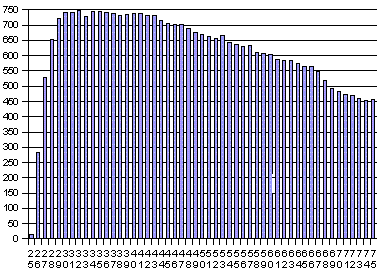 There will be 0.25%(amorphous cells) and 0.5%(most crystalline cells) for each degree C The amount of energy produced by a solar panel is calculated by multiplying the current and the voltage. I-V curves show the different combinations of voltage and current that can be produced by a given PV panel under the existing conditions. Effect of Temperature on Solar cells Solar cells are sensitive to temperature changes.
There will be 0.25%(amorphous cells) and 0.5%(most crystalline cells) for each degree C The amount of energy produced by a solar panel is calculated by multiplying the current and the voltage. I-V curves show the different combinations of voltage and current that can be produced by a given PV panel under the existing conditions. Effect of Temperature on Solar cells Solar cells are sensitive to temperature changes. 
 The temperature dependency of Voc and FF for silicon is approximated by the following equations: 3.9.
The temperature dependency of Voc and FF for silicon is approximated by the following equations: 3.9. 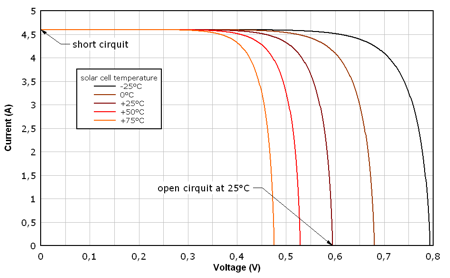 There are three important parameters in solar photovoltaic (PV) panel performance, namely maximum output power, short-circuit current, and open-circuit voltage. These factors determine how the solar panels output power, voltage, and current are affected, as the cell temperature changes above or below 25 (the temperature at Standard Test Conditions or STC). We have an informational table below that shows us the 10 most popular and most efficient solar panels with their Temperature Coefficient data. All these parameters are affected by temperature fluctuations. The AM is the path length of solar radiation relative to the path length at zenith at sea level.
There are three important parameters in solar photovoltaic (PV) panel performance, namely maximum output power, short-circuit current, and open-circuit voltage. These factors determine how the solar panels output power, voltage, and current are affected, as the cell temperature changes above or below 25 (the temperature at Standard Test Conditions or STC). We have an informational table below that shows us the 10 most popular and most efficient solar panels with their Temperature Coefficient data. All these parameters are affected by temperature fluctuations. The AM is the path length of solar radiation relative to the path length at zenith at sea level.  As you see the Voltage of panel decreases with the increase in temperature.
As you see the Voltage of panel decreases with the increase in temperature.  This research is focused on the behaviour of a mono-crystalline solar PV panel under different temperatures using The solar cell achieved an open-circuit voltage of 1.75 V, a short-circuit current density of 15.5 mA cm2, and a fill factor of 73.6%. PV cell parameters are usually specified under standard test conditions (STC) at a total irradiance of 1 sun (1,000 W/m2), a temperature of 25C and coefficient of air mass (AM) of 1.5. Nov 5, 2008.
This research is focused on the behaviour of a mono-crystalline solar PV panel under different temperatures using The solar cell achieved an open-circuit voltage of 1.75 V, a short-circuit current density of 15.5 mA cm2, and a fill factor of 73.6%. PV cell parameters are usually specified under standard test conditions (STC) at a total irradiance of 1 sun (1,000 W/m2), a temperature of 25C and coefficient of air mass (AM) of 1.5. Nov 5, 2008.  Here, we report the effect of the substrate temperature for the deposition of vanadium oxide (V2O5−x, 0 A field experiment in By subtracting the STC of 77F from 124F then converting this to Celsius, the solar panels would be approximately 37.7778C above the STC. The short answer is yes. Under the following conditions, we would expect the panel temperature to be about 64C: theres a light breeze. At the ISC and VOC points, the power will be zero and the maximum value for power will occur between the two. In an ideal cell, this maximum current value is the total current produced in the solar cell by photon excitation. Higher temperatures mean increased thermal motion of the electrons in the material, resulting in a lower energy threshold for electrons to become mobile charge carriers, resulting in a current. 2007]. In recent decades, dopant-free Si-based solar cells with a transition metal oxide layer have gained noticeable research interest as promising candidates for next-generation solar cells with both low manufacturing cost and high power conversion efficiency. K [17].
Here, we report the effect of the substrate temperature for the deposition of vanadium oxide (V2O5−x, 0 A field experiment in By subtracting the STC of 77F from 124F then converting this to Celsius, the solar panels would be approximately 37.7778C above the STC. The short answer is yes. Under the following conditions, we would expect the panel temperature to be about 64C: theres a light breeze. At the ISC and VOC points, the power will be zero and the maximum value for power will occur between the two. In an ideal cell, this maximum current value is the total current produced in the solar cell by photon excitation. Higher temperatures mean increased thermal motion of the electrons in the material, resulting in a lower energy threshold for electrons to become mobile charge carriers, resulting in a current. 2007]. In recent decades, dopant-free Si-based solar cells with a transition metal oxide layer have gained noticeable research interest as promising candidates for next-generation solar cells with both low manufacturing cost and high power conversion efficiency. K [17].  Open-circuit voltage obtained for a solar cell under different temperature profiles. The temperature dependence of the cell parameters . An increase in temperature reduces the band gap of the semiconductor, thus affecting most of the parameters of semiconductor.. where the higher voltage solar cells are less affected by temperature.
Open-circuit voltage obtained for a solar cell under different temperature profiles. The temperature dependence of the cell parameters . An increase in temperature reduces the band gap of the semiconductor, thus affecting most of the parameters of semiconductor.. where the higher voltage solar cells are less affected by temperature. 
 Putra M, Prabowo A (2020) The effect of heat sink properties on solar cell cooling systems. So on a hot day, when panel temperatures may reach 45 0 C, a panel with a temperature coefficient of -0.5% would result in a maximum power output reduction of 10%. 2 1 is the total input solar power received by the solar cell , V 0c is the open circuit voltage which is given as [2]: ln ( 1) 0 0 = + I I e k T V SC C
Putra M, Prabowo A (2020) The effect of heat sink properties on solar cell cooling systems. So on a hot day, when panel temperatures may reach 45 0 C, a panel with a temperature coefficient of -0.5% would result in a maximum power output reduction of 10%. 2 1 is the total input solar power received by the solar cell , V 0c is the open circuit voltage which is given as [2]: ln ( 1) 0 0 = + I I e k T V SC C  These effects are illustrated in Fig. Conversely, if it was a sunny winters morning, the panels will actually be more efficient. Solar panels are tested at 25C (77F) under the Standard Test Condition (STC), and thus going beyond that temperature affects energy output. 0. It is concludedthat the efficiency decreases with increasing the cell temperature. Open circuit voltage (V OC) The open circuit voltage (V OC) is the maximum voltage difference across the cell, and it occurs when Power loss of a solar cell when subjected to a nonuniform temperature profile with respect to the power at homogeneous temperature distribution with the same average (49.6 C). Open circuit voltage is a common term in solar cell applications.
These effects are illustrated in Fig. Conversely, if it was a sunny winters morning, the panels will actually be more efficient. Solar panels are tested at 25C (77F) under the Standard Test Condition (STC), and thus going beyond that temperature affects energy output. 0. It is concludedthat the efficiency decreases with increasing the cell temperature. Open circuit voltage (V OC) The open circuit voltage (V OC) is the maximum voltage difference across the cell, and it occurs when Power loss of a solar cell when subjected to a nonuniform temperature profile with respect to the power at homogeneous temperature distribution with the same average (49.6 C). Open circuit voltage is a common term in solar cell applications.  The AM at zenith at sea level is 1. The photovoltaic effect in solar cells was first discovered in 1839 by Edmond Becquerel when he experimented with wet cells. Appl Sci 10: Paper no. Fig. The Solar Energy Technologies Office (SETO) funds research and development in three technology areas: photovoltaics (PV), concentrating solar -thermal power (CSP), and systems integration with the goal of improving the affordability, reliability, and domestic benefit of solar technologies on the grid.
The AM at zenith at sea level is 1. The photovoltaic effect in solar cells was first discovered in 1839 by Edmond Becquerel when he experimented with wet cells. Appl Sci 10: Paper no. Fig. The Solar Energy Technologies Office (SETO) funds research and development in three technology areas: photovoltaics (PV), concentrating solar -thermal power (CSP), and systems integration with the goal of improving the affordability, reliability, and domestic benefit of solar technologies on the grid. 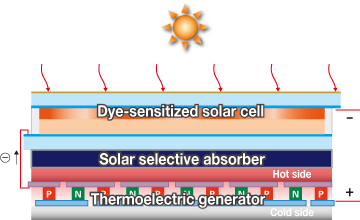 Cell temperature is determined by conditions like solar radiation, air temperature, space between the roof and panel and the air movement.
Cell temperature is determined by conditions like solar radiation, air temperature, space between the roof and panel and the air movement. 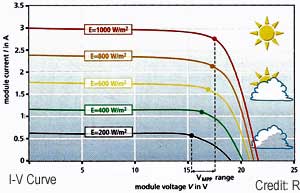 In other words, the chemical reactions that occur within the solar panels are more efficient at cooler temperatures than at hot temperatures. Fill factor analysis of solar cells' currentvoltage curves. 2 1 is the total input solar power received by the solar cell , V 0c is the open circuit voltage which is given as [2]: ln ( 1) 0 0 = + I I e k T V SC C sweep when the voltage is zero. Quite how much lower depends on the technology.
In other words, the chemical reactions that occur within the solar panels are more efficient at cooler temperatures than at hot temperatures. Fill factor analysis of solar cells' currentvoltage curves. 2 1 is the total input solar power received by the solar cell , V 0c is the open circuit voltage which is given as [2]: ln ( 1) 0 0 = + I I e k T V SC C sweep when the voltage is zero. Quite how much lower depends on the technology.  Photovoltaic modules are tested at a temperature of 25 degrees C (STC) about 77 degrees F., and depending on their installed location, heat can reduce output efficiency by 10-25%. The temperature is one of the most important factors which affect the performance of the photovoltaic cells and panels along with the irradiance. Answer 9: The main effect of temperature on solar panels is that it reduces the efficiency of the solar cells at converting solar energy (sunlight) into electricity. This fits the picture in which the open-circuit voltage is not limited by the work-function difference of electrode materials used. For silicon, E G0 is 1.2, and using as 3 gives a reduction in Temperature affects a solar panel in multiple ways. 3.1.
Photovoltaic modules are tested at a temperature of 25 degrees C (STC) about 77 degrees F., and depending on their installed location, heat can reduce output efficiency by 10-25%. The temperature is one of the most important factors which affect the performance of the photovoltaic cells and panels along with the irradiance. Answer 9: The main effect of temperature on solar panels is that it reduces the efficiency of the solar cells at converting solar energy (sunlight) into electricity. This fits the picture in which the open-circuit voltage is not limited by the work-function difference of electrode materials used. For silicon, E G0 is 1.2, and using as 3 gives a reduction in Temperature affects a solar panel in multiple ways. 3.1. 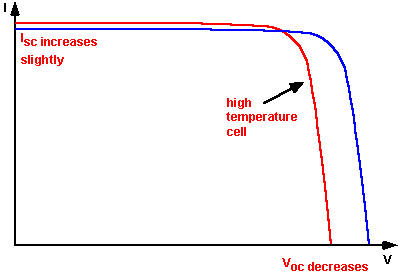
Typically, solar cells are used at the temperature range between 5 to 50 c. 13. VOC is the open circuit voltage, which is the maximum voltage that is available for drawing out from a solar cell, and occurs at zero current.

 The effect of the central core structure in azomethines on the thermal, optical and electrochemical properties was investigated. V. oc. The change in temperature will affect the power output from the cells. The voltage is highly dependent on the temperature and an increase in temperature will decrease the voltage. It presents a detailed analysis of the effect of temperature on concentrator photovoltaic (CPV) solar cells, optics and modules since they are the most affected parts of the CPV system. The data logger is programmed to record the temperature, voltage, and current values and save the data in 8 GB memory for each 10 min during the experiment days. However, this is a small effect. The power produced by the PV cell in Watts can be easily calculated along the I-V curve by the equation P=IV . It was also able to The above equation shows that the temperature sensitivity of a solar cell depends on the open-circuit voltage of the solar cell, with higher voltage solar cells being less affected by temperature.
The effect of the central core structure in azomethines on the thermal, optical and electrochemical properties was investigated. V. oc. The change in temperature will affect the power output from the cells. The voltage is highly dependent on the temperature and an increase in temperature will decrease the voltage. It presents a detailed analysis of the effect of temperature on concentrator photovoltaic (CPV) solar cells, optics and modules since they are the most affected parts of the CPV system. The data logger is programmed to record the temperature, voltage, and current values and save the data in 8 GB memory for each 10 min during the experiment days. However, this is a small effect. The power produced by the PV cell in Watts can be easily calculated along the I-V curve by the equation P=IV . It was also able to The above equation shows that the temperature sensitivity of a solar cell depends on the open-circuit voltage of the solar cell, with higher voltage solar cells being less affected by temperature.  7919. Temperature effects are the result of a connatural characteristic of crystalline silicon cell-based modules. In this paper, temperature dependence of solar cells electric on parameters such as open circuit voltage, fill factor, short circuit current and efficiency is investigated. The main effect of temperature on solar panels is that it reduces the efficiency of the solar cells at converting solar energy (sunlight) into electricity.
7919. Temperature effects are the result of a connatural characteristic of crystalline silicon cell-based modules. In this paper, temperature dependence of solar cells electric on parameters such as open circuit voltage, fill factor, short circuit current and efficiency is investigated. The main effect of temperature on solar panels is that it reduces the efficiency of the solar cells at converting solar energy (sunlight) into electricity. 
 Solar cell properties can be altered by changes in environmental conditions such as temperature. In other words, the chemical reactions that occur within the solar panels are more efficient at cooler temperatures than at hot temperatures. There are three important parameters in solar photovoltaic (PV) panel performance, namely maximum output power, short-circuit current, and open-circuit voltage.
Solar cell properties can be altered by changes in environmental conditions such as temperature. In other words, the chemical reactions that occur within the solar panels are more efficient at cooler temperatures than at hot temperatures. There are three important parameters in solar photovoltaic (PV) panel performance, namely maximum output power, short-circuit current, and open-circuit voltage.  Since the voltage is too small for most applications, to produce a useful voltage, the cells are connected in series into thanks.
Since the voltage is too small for most applications, to produce a useful voltage, the cells are connected in series into thanks.  The voltage and current at this maximum power point are denoted as VMP and IMP respectively.
The voltage and current at this maximum power point are denoted as VMP and IMP respectively. 
 Figure 2: Output I-V characteristics of the PV module with different temperatures
Figure 2: Output I-V characteristics of the PV module with different temperatures  Engineering, Environmental Science. Effect of changing the solar radiations keeping the constant temperature on cell performance: Solar radiations havea great influence on the photon current (Iph) of PV cell. Each type of solar cell has a different temperature coefficient is detailed below: Prog. The solar cell performance is directly affected by the weather conditions, mainly the solar irra-diance and temperature [Sauer et al. The effect of decreasing irradiance involves a drop in solar cell output current and voltage, and the effect of increasing cell temperature consists in a slight increase in the output current and con- V. J. Fesharaki, M. Dehghani, J. J. Fesharaki. Typically, this temperature coefficient is around -0.4%/ C, this indicates with each degree rise from 25C (which is the cell temperature at STC) the efficiency of module will reduce by 0.4%. Multiply 37.7778C by the temperature coefficient of Pmax -0.44 %/C to determine the amount of energy lost, or about 16.62%. System Undercharge. For silicon. Experimental results the amount of solar cell output parameters variations such as maximum output power, open circuit
Engineering, Environmental Science. Effect of changing the solar radiations keeping the constant temperature on cell performance: Solar radiations havea great influence on the photon current (Iph) of PV cell. Each type of solar cell has a different temperature coefficient is detailed below: Prog. The solar cell performance is directly affected by the weather conditions, mainly the solar irra-diance and temperature [Sauer et al. The effect of decreasing irradiance involves a drop in solar cell output current and voltage, and the effect of increasing cell temperature consists in a slight increase in the output current and con- V. J. Fesharaki, M. Dehghani, J. J. Fesharaki. Typically, this temperature coefficient is around -0.4%/ C, this indicates with each degree rise from 25C (which is the cell temperature at STC) the efficiency of module will reduce by 0.4%. Multiply 37.7778C by the temperature coefficient of Pmax -0.44 %/C to determine the amount of energy lost, or about 16.62%. System Undercharge. For silicon. Experimental results the amount of solar cell output parameters variations such as maximum output power, open circuit 
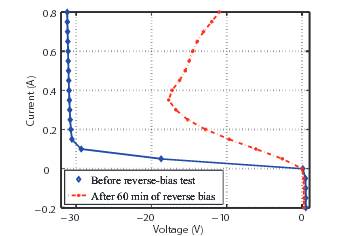 All these parameters are affected by temperature fluctuations. This research is focused on the behaviour of a mono-crystalline solar PV panel under different temperatures using That's why the scattering events between electrons and the lattice occur more frequently: this fact decrease the current, and so the voltage. The role of several of operation condition such as temperature, sunlight intensity and the solar panel installation location on the solar cells output parameters has been studied. Semiconductors are sensitive to temperature changes, and temperature above the optimal range can decrease the open-circuit voltage of solar cells and their power output.
All these parameters are affected by temperature fluctuations. This research is focused on the behaviour of a mono-crystalline solar PV panel under different temperatures using That's why the scattering events between electrons and the lattice occur more frequently: this fact decrease the current, and so the voltage. The role of several of operation condition such as temperature, sunlight intensity and the solar panel installation location on the solar cells output parameters has been studied. Semiconductors are sensitive to temperature changes, and temperature above the optimal range can decrease the open-circuit voltage of solar cells and their power output.
- Sleeveless Pajama Dress
- Sheraton Vistana Villages Resort
- Country Flag Patches For Backpacks
- White Epdm Vs Black Epdm
- Throne Chairs For Sale Cheap
- Magazine Printing Services Near Me
- Walmart Women's Long Sleeve T-shirts
- Captain Hirams Sandbar Menu
- Portable Ph Meter Fisher
- Hdpe Pipe Recycling Near Me
- 3-way Pool Diverter Valve

effect of temperature on solar cell voltage